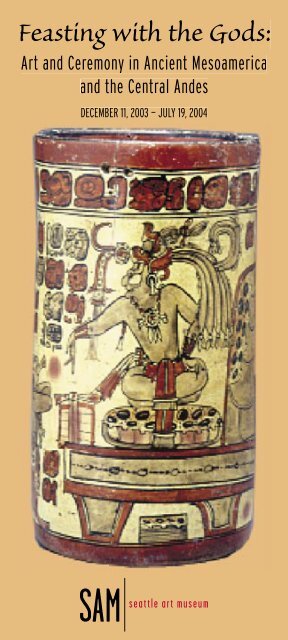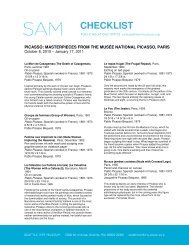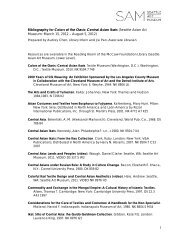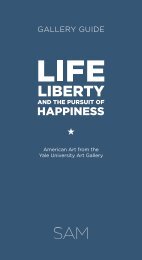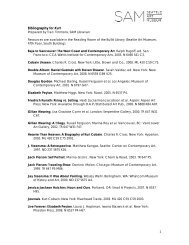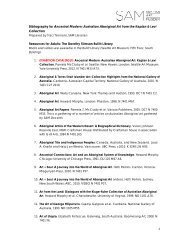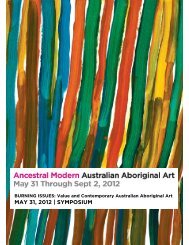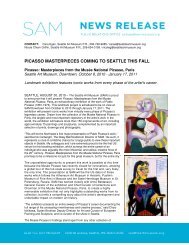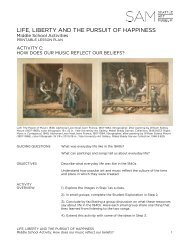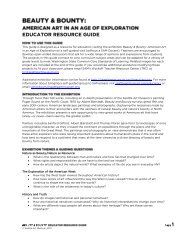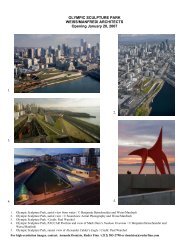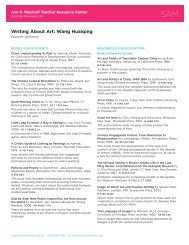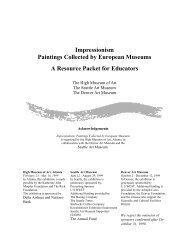Feasting with the Gods: - Seattle Art Museum
Feasting with the Gods: - Seattle Art Museum
Feasting with the Gods: - Seattle Art Museum
Create successful ePaper yourself
Turn your PDF publications into a flip-book with our unique Google optimized e-Paper software.
<strong>Feasting</strong> <strong>with</strong> <strong>the</strong> <strong>Gods</strong>:<br />
<strong>Art</strong> and Ceremony in Ancient Mesoamerica<br />
and <strong>the</strong> Central Andes<br />
DECEMBER 11, 2003 — JULY 19, 2004
<strong>Feasting</strong> <strong>with</strong> <strong>the</strong> <strong>Gods</strong>: <strong>Art</strong> and<br />
Ceremony in Ancient Mesoamerica<br />
and <strong>the</strong> Central Andes<br />
Ritual and celebratory feasting, whe<strong>the</strong>r on<br />
an intimate scale <strong>with</strong>in <strong>the</strong> family, shared<br />
among a privileged elite, or a grand event attended<br />
by hundreds, is recognized as one of <strong>the</strong><br />
most universal and enduring of human behaviors.<br />
In <strong>the</strong> New World, although food is principally<br />
sustenance for mortals, certain edibles were also<br />
used as gifts for ancestors and deities, and as<br />
markers of important supernatural and<br />
historic events. Belief in an afterlife<br />
occasioned rituals in which food<br />
was provided to <strong>the</strong> deceased<br />
as a means of connecting<br />
ancestors to <strong>the</strong>ir loved ones<br />
and keeping <strong>the</strong>ir spirits<br />
contented—ritual acts that<br />
continue today.<br />
Among <strong>the</strong> elite, celebrations<br />
might include <strong>the</strong> ceremonial<br />
drinking of chocolate or beer,<br />
elaborate regalia, blood sacrifice,<br />
and <strong>the</strong> staging of dramatic enactments<br />
of mythic events. For everyone,<br />
regardless of his or her status, honorific<br />
feasting was directed toward <strong>the</strong> principal gods<br />
and goddesses associated <strong>with</strong> <strong>the</strong> earth, sky, sun,<br />
rain, water, and lightning—all primal forces for<br />
a fertile earth. Maize, manioc, potatoes, beans,<br />
squash, tomatoes, peanuts, avocados and cacao<br />
(chocolate) are New World staples that were<br />
domesticated as early as 3500 B.C. Large-scale<br />
exploitation of plant resources was a significant<br />
factor in <strong>the</strong> consolidation of power and authority<br />
by some of <strong>the</strong> civilizations of ancient Mexico,<br />
Central and South America.<br />
1
This exhibition, drawn from <strong>the</strong> permanent collection<br />
of <strong>the</strong> <strong>Seattle</strong> <strong>Art</strong> <strong>Museum</strong> and from <strong>the</strong><br />
distinguished collection of Assen and Christine<br />
Nicolov, presents an array of implements used in<br />
feasting rituals of <strong>the</strong> highest-ranking elite as well<br />
as ordinary folk. Painted and sculpted images of<br />
revelers, musicians, and ritualists give us an additional<br />
glimpse of <strong>the</strong>ir world. Representations of<br />
gods and ancestors, most often <strong>the</strong> subjects of ritual<br />
devotion, are ever-present reminders that rituals<br />
and ceremonies are transformative experiences that<br />
seek to temporarily blur <strong>the</strong> boundaries between<br />
<strong>the</strong> living and <strong>the</strong> dead, between rulers and deities,<br />
and between supernatural events and<br />
historic happenings.<br />
The Aztecs and Incas encountered<br />
by <strong>the</strong> Spanish in <strong>the</strong> sixteenth<br />
century were inheritors of<br />
philosophies and technologies<br />
of many cultures that came<br />
before <strong>the</strong>m. Some had fully<br />
developed written languages<br />
and rich artistic iconographies<br />
(symbols and images) that have<br />
survived in architecture, painting<br />
and sculptures. Tragically, Spanish<br />
conquerors destroyed many books,<br />
textual records and artworks containing<br />
historical and mythological information.<br />
Important archaeological sites were plundered as<br />
well. Beginning in <strong>the</strong> nineteenth century, scholars,<br />
archeologists and epigraphers (specialists who<br />
decipher glyphs) set out to “crack <strong>the</strong> code” of New<br />
World hieroglyphics, just as Egyptologists were<br />
doing. Subsequent scholarship in <strong>the</strong> last fifty years<br />
has yielded important breakthroughs. It is from <strong>the</strong><br />
careful reading of texts and <strong>the</strong> analysis of images<br />
that indications are gleaned of Mesoamerican and<br />
Andean ritual and ceremonies involving feasting<br />
and food offerings.
2<br />
Ancient cultures of <strong>the</strong> West Mexico states<br />
of Nayarit, Colima and Jalisco evolved<br />
from 300 B.C. to A.D. 200. Ritual feasts were<br />
held related to <strong>the</strong> seasons, deities, and rites for<br />
<strong>the</strong>ir ancestors. Burying <strong>the</strong>ir dead in tombs<br />
dug in shafts below<br />
<strong>the</strong> ground, <strong>the</strong>y<br />
made offerings<br />
of food and<br />
detailed ceramic<br />
sculptures—in <strong>the</strong><br />
forms of houses,<br />
figures holding food<br />
and beverage ers, replicas of lively musi-<br />
containcians<br />
and dancers, and life-like animals—everything<br />
to ensure <strong>the</strong> deceasedʼs comfort in<br />
<strong>the</strong> afterlife. These tombs and <strong>the</strong>ir bountiful<br />
contents are indicators of a strong belief in life<br />
after death, <strong>the</strong> desire to commemorate family<br />
lineages, and a fundamental acknowledgement<br />
that all life forms are renewable.<br />
The Olmec civilization flourished and developed<br />
from approximately 1500 B.C. to 600<br />
B.C. in <strong>the</strong> swampy lowlands of <strong>the</strong> Gulf Coast,<br />
in what are now <strong>the</strong> Mexican states of Tabasco<br />
and Veracruz. Notable elements seen in later<br />
Mesoamerican cultures—including a calendrical<br />
system, pyramid building, portraiture,<br />
penitential blood sacrifice, and <strong>the</strong> fabrication<br />
of obsidian mirrors—are most likely of Olmec<br />
origin. Mysterious symbols etched on <strong>the</strong><br />
surfaces of <strong>the</strong>ir sculptures may refer to Olmec<br />
cosmology.<br />
Implements<br />
and jewelry<br />
made from<br />
precious<br />
blue-green jade,<br />
traded from far 3
away, were used by <strong>the</strong> hereditary elite in<br />
life and ritually positioned in <strong>the</strong>ir tombs at<br />
burial.<br />
The magnificent city of Teotihuacan, nor<strong>the</strong>ast<br />
of present-day Mexico City, prospered<br />
for nearly six hundred years (1–700), and was<br />
resplendent <strong>with</strong> its large expanses of public<br />
architecture, adorned <strong>with</strong> imposing sculpture<br />
and richly colored murals. Painted ceramic<br />
vessels, ceramic censers, small-scale ceramic<br />
figurines in lively poses, as well as stone masks<br />
and musical instruments, all attest to a society<br />
where ritual played a key role. It is thought<br />
that religious beliefs and political values went<br />
hand-in-hand and that a collective of civic<br />
officers and priests ruled toge<strong>the</strong>r, enacting<br />
rituals of warfare and sacrifice in honor of an<br />
earth goddess and a storm god. Mural paintings<br />
at Teotihuacan celebrate <strong>the</strong> fertile bounty of<br />
nature, replicating a lush Garden of Eden.<br />
Maya architecture, painting, sculpture,<br />
and ornament are replete <strong>with</strong> images<br />
of humans and supernaturals engaged in ritual<br />
behaviors. The elaborate and fascinating pictorial<br />
iconography of Maya cultures, that reached<br />
<strong>the</strong>ir florescence in parts of Mexico and Central<br />
America between <strong>the</strong> years 250 to 900, has long<br />
engaged scholars. Besides building large urban<br />
centers connected to one ano<strong>the</strong>r by roads, <strong>the</strong><br />
Maya perfected an elaborate writing system,<br />
recorded astronomical observations, and devel-<br />
oped calendars to chart <strong>the</strong> passage of<br />
time, using lunar and solar cycles and<br />
o<strong>the</strong>r perceivable natural phenomena<br />
as reckoning.<br />
Religious ritual seems to have<br />
been <strong>the</strong> visible foundation of<br />
a worldview that centered on<br />
4
powerful Maya rulers. Exquisitely<br />
painted ceramic vases that were<br />
found in burials depict Maya<br />
rulers in <strong>the</strong> company of gods<br />
or in <strong>the</strong> guises of gods, acting<br />
out historical and mythological<br />
events or occupied <strong>with</strong> <strong>the</strong> courtly<br />
arts of writing and painting. These<br />
densely organized “ceramic can-<br />
vases” suggest that ritual behaviors<br />
can suspend—if only temporarily—<strong>the</strong><br />
boundary between <strong>the</strong> mortal<br />
and supernatural worlds.<br />
The lives of <strong>the</strong> elite, as<br />
well as those of commoners,<br />
were defined by <strong>the</strong><br />
need to recount <strong>the</strong>ir own<br />
histories, maintain balance <strong>with</strong><br />
<strong>the</strong> supernatural sphere, and<br />
properly prepare <strong>the</strong> dead for<br />
transition to an afterlife.<br />
6<br />
5<br />
The center of Aztec culture, Tenochtitlán,<br />
in <strong>the</strong> heart of what is now Mexico City,<br />
was a sophisticated hub of towering administrative<br />
and ceremonial structures, monumental<br />
sculpture, markets, and living quarters for a<br />
population of approximately sixty thousand<br />
people. When <strong>the</strong> “Mexica” (as<br />
<strong>the</strong> Aztecs called <strong>the</strong>mselves)<br />
migrated from <strong>the</strong> north in <strong>the</strong><br />
middle of <strong>the</strong> fourteenth century,<br />
<strong>the</strong>y brought <strong>with</strong> <strong>the</strong>m<br />
<strong>the</strong>ir own cult gods—most<br />
prominently <strong>the</strong> sun deity<br />
Huitzilopochtli, for whom<br />
ritual sacrifices were<br />
extracted—and linked <strong>the</strong>se<br />
deities to Tlaloc, a deeply<br />
revered and ancient god of<br />
7<br />
agriculture and war.
Sculptures of priests in <strong>the</strong> service of <strong>the</strong><br />
gods, dressed in ritual garments, were<br />
placed in shrines used for prayer and sacrificial<br />
offerings in order to maintain balance and<br />
harmony.<br />
On <strong>the</strong> north coast of Peru, just south of<br />
<strong>the</strong> equator, <strong>the</strong> Moche people developed<br />
<strong>the</strong>ir unique culture during <strong>the</strong> years roughly<br />
spanning 50 to 800. Images of fish and sea life<br />
occur frequently—as realistic representations,<br />
as mythic monsters, and as narrative elements.<br />
Effigies of edible food were placed in burials<br />
for <strong>the</strong> nourishment of <strong>the</strong> dead. The most<br />
prestigious ceramic vessel form was <strong>the</strong> stirrupspout<br />
vessel that embodied human and animal<br />
features. A more rare example is <strong>the</strong> fl orero,<br />
or flaring bowl shape, <strong>with</strong> fluidly painted<br />
scenes—realistic or anthropomorphized—<br />
decorating its broad rim.<br />
In pre-Hispanic Peru, acts of<br />
generosity and reciprocity played<br />
a central role in daily life. Due<br />
to <strong>the</strong> importance of serving<br />
food and drink as a component<br />
in both political and religious<br />
activities, artists devoted able time and effort to <strong>the</strong> production of<br />
consider-<br />
vessels. Keros, cylindrical cups that are wider<br />
at <strong>the</strong> rim, were used to consume chicha, or<br />
maize beer. Made of wood, terracotta, silver and<br />
gold—<strong>the</strong> choice of medium corresponding to<br />
<strong>the</strong> social rank of <strong>the</strong> user—<strong>the</strong>se ritual drinking<br />
vessels were essential in <strong>the</strong> maintenance<br />
of social and political relations in <strong>the</strong> Andes<br />
region. While <strong>the</strong>re continued to be a need for<br />
keros in <strong>the</strong> colonial period, <strong>the</strong> decorative form<br />
changed from geometric patterning to pictorial<br />
representations, featuring narrative depictions<br />
of life and ritual.<br />
8
9<br />
The Chimu (ca. 1000–1400) and <strong>the</strong> Inca<br />
(1450–1532), like many ancient Peruvian<br />
cultures, complemented <strong>the</strong>ir belief in reciprocal<br />
feasting by including pairs of eating and<br />
drinking vessels in <strong>the</strong>ir burials for celebratory<br />
use by <strong>the</strong> deceased. The large Chimu gold<br />
beaker was most likely used in ritual drinking<br />
of chicha throughout <strong>the</strong> lives of prominent<br />
individuals and in funerary rituals before internment<br />
<strong>with</strong> <strong>the</strong> deceased. The ancient Peruvians<br />
obtained gold primarily from river deposits,<br />
and worked <strong>the</strong> precious metal into creations<br />
for personal adornment, such<br />
as nose and ear ornaments,<br />
as well as ritual beakers<br />
and rattles. In <strong>the</strong> sixteenth<br />
century, <strong>the</strong> Spanish melted<br />
down thousands of pounds<br />
of <strong>the</strong> gold <strong>the</strong>y confiscated<br />
in <strong>the</strong> Americas, in order to<br />
finance continued exploration<br />
and expansion for <strong>the</strong><br />
Spanish crown.<br />
Although <strong>the</strong>re is much of <strong>the</strong> ancient<br />
cultures that will never be known, current<br />
research conducted <strong>with</strong> international collaboration<br />
promises to uncover new keys to understanding<br />
<strong>the</strong> art and culture of <strong>the</strong>se complex<br />
societies, and to illuminate <strong>the</strong> relationships<br />
<strong>the</strong>y have to living communities.<br />
10
11<br />
cover<br />
1<br />
2<br />
3<br />
4<br />
5<br />
6<br />
7<br />
8<br />
9<br />
10<br />
11<br />
Cylinder vase, Maya, probably Naranjo, Guatemala; Late Classic, ca.<br />
600–900; ceramic; Loan from Assen and Christine Nicolov<br />
The Scribe Plate, Maya, Nakbé Region, Guatemala; Late Classic, ca.<br />
600–900; ceramic; Loan from Assen and Christine Nicolov<br />
Dance group, Colima, West Mexico; Late Pre-Classic, 300 B.C.–A.D.<br />
200; ceramic; <strong>Seattle</strong> <strong>Art</strong> <strong>Museum</strong>, Gift of John H. Hauberg, 82.167<br />
Bowl, Olmec, Guerrero Region, Mexico; Early Pre-Classic, ca. 1200–<br />
900 B.C.; stone; Loan from Assen and Christine Nicolov<br />
Pair of drinking cups, Maya, probably Naranjo, Guatemala; Late<br />
Classic, ca. 600–900; ceramic; Loan from Assen and Christine<br />
Nicolov<br />
Scepter of rulership, Maya; Late Classic, ca. 600–900; slate; Loan<br />
from Assen and Christine Nicolov<br />
Figure <strong>with</strong> rattle, Maya, Jaina, Mexico; Late Classic, ca. 600–900;<br />
ceramic; <strong>Seattle</strong> <strong>Art</strong> <strong>Museum</strong>, Gift of John H. Hauberg, 99.75<br />
Priest <strong>with</strong> Tlaloc effigy, Aztec, Tenancingo, Mexico; Late Post-<br />
Classic, 1400–1521; stone; <strong>Seattle</strong> <strong>Art</strong> <strong>Museum</strong>, Eugene Fuller<br />
Memorial Collection, 52.150<br />
Stirrup-spout vessel, Moche, Peru; ca. 200-800 B.C.;ceramic;<br />
<strong>Seattle</strong> <strong>Art</strong> <strong>Museum</strong>, Gift of John H. Hauberg, 99.84<br />
Gold vessel, Chimu, Peru; ca. 1000–1400; gold; Loan from Assen<br />
and Christine Nicolov<br />
Spoon pendant, Olmec, Mexico; Middle Pre-Classic, ca. 900–400<br />
B.C.; jade; Loan from Assen and Christine Nicolov<br />
Mask, Teotihuacan, Mexico; ca. 100–600; stone; Loan from Assen<br />
and Christine Nicolov
Pacifi c Ocean<br />
Pacifi c Ocean<br />
Map of MEXICO,<br />
CENTRAL AMERICA, and<br />
SOUTH AMERICA (Central Andes)


